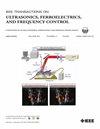用射频变压器产生贝塞尔光束。
IF 3.7
2区 工程技术
Q1 ACOUSTICS
IEEE transactions on ultrasonics, ferroelectrics, and frequency control
Pub Date : 2025-08-21
DOI:10.1109/TUFFC.2025.3601216
引用次数: 0
摘要
贝塞尔光束是各向同性/齐次波动方程的精确解。理论上,它们可以不经衍射而传播到无限大的距离。在实践中,当产生有限孔径时,它们具有非常大的景深,也就是说,它们可以在很大的距离内保持较小的波束宽度。此外,它们在遇到障碍后具有自愈能力。由于这些特性,贝塞尔光束在光学、电磁学、超声、量子通信、电子束制导等领域都有应用。以前,在超声领域,贝塞尔光束是由多个独立的高压射频(RF)功率放大器驱动的环形阵列换能器产生的,体积大、重量重、功耗大,这限制了贝塞尔光束在可穿戴医学超声成像和可穿戴超分辨率成像等应用中的应用。在本文中,脉冲(宽带)贝塞尔光束是由一个高压射频功率放大器与一个射频变压器相结合产生的,从而减小了尺寸、重量和功耗。实验采用定制射频变压器和定制10环,直径50 mm,中心频率2.5 mhz,宽带(约72% -6 dB相对单向带宽)1-3锆钛酸铅(PZT)陶瓷/聚合物复合环形阵列换能器,由商用射频功率放大器驱动,电压约为+/-90 V,在水中产生脉冲贝塞尔光束。结果表明,该脉冲贝塞尔光束与10个独立的高压射频功率放大器、计算机模拟和理论产生的脉冲贝塞尔光束非常接近,脉冲贝塞尔光束的波束宽度为-6 dB,约为2.53 mm(4.22波长),景深约为216 mm(360波长)。高压射频功率放大器数量的减少使得贝塞尔光束更容易应用于可穿戴医疗超声成像和可穿戴超分辨率成像等应用,如使用贝塞尔光束和机械扫描的多向振动反射器可以产生三维(3D)或多平面图像的示例所示。本文章由计算机程序翻译,如有差异,请以英文原文为准。
Producing Bessel Beams With an RF Transformer
Bessel beams are exact solutions to the isotropic/homogeneous wave equation. In theory, they can propagate to infinite distances without diffraction. In practice, when produced with a finite aperture, they have a very large depth of field, i.e., they can maintain a small beamwidth over a large distance. In addition, they have a self-healing ability after encountering an obstacle. Because of these properties, Bessel beams have applications in optics, electromagnetics, ultrasound, quantum communications, electron beam guidance, and so on. Previously, in ultrasound, Bessel beams were produced with an annular array transducer driven by multiple independent high-voltage radio frequency (RF) power amplifiers that were bulky, heavy, and consumed a lot of power, which limited the Bessel beams in applications such as wearable medical ultrasound imaging and wearable super-resolution imaging. In this article, pulse (broadband) Bessel beams were produced by a single high-voltage RF power amplifier in combination with an RF transformer, reducing the size, weight, and power consumption. Experiments were performed to produce the pulse Bessel beams in water with a custom RF transformer and a custom ten-ring, 50-mm diameter, 2.5-MHz center frequency, and broadband (about 72% -6 dB relative one-way bandwidth) 1–3 lead zirconate titanate (PZT) ceramic/polymer composite annular array transducer driven by a commercial RF power amplifier at about ±90 V. The results show that the pulse Bessel beams produced were very close to those generated with ten independent high-voltage RF power amplifiers, computer simulations, and theory, and the pulse Bessel beams had a -6-dB beamwidth of about 2.53 mm ( $4.22\lambda $ ) and a depth of field of about 216 mm ( $360\lambda $ ). The reduced number of high-voltage RF power amplifiers makes it easier to apply Bessel beams in applications such as wearable medical ultrasound imaging and wearable super-resolution imaging, as is illustrated in examples where three-dimensional (3-D) or multi-plane images can be produced using a Bessel beam and a mechanically scanned multi-directional vibrating reflector.
求助全文
通过发布文献求助,成功后即可免费获取论文全文。
去求助
来源期刊
CiteScore
7.70
自引率
16.70%
发文量
583
审稿时长
4.5 months
期刊介绍:
IEEE Transactions on Ultrasonics, Ferroelectrics and Frequency Control includes the theory, technology, materials, and applications relating to: (1) the generation, transmission, and detection of ultrasonic waves and related phenomena; (2) medical ultrasound, including hyperthermia, bioeffects, tissue characterization and imaging; (3) ferroelectric, piezoelectric, and piezomagnetic materials, including crystals, polycrystalline solids, films, polymers, and composites; (4) frequency control, timing and time distribution, including crystal oscillators and other means of classical frequency control, and atomic, molecular and laser frequency control standards. Areas of interest range from fundamental studies to the design and/or applications of devices and systems.

 求助内容:
求助内容: 应助结果提醒方式:
应助结果提醒方式:


